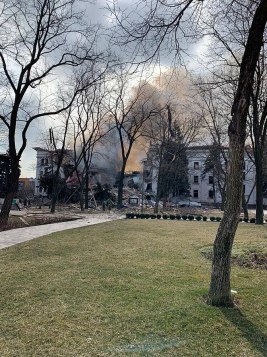Wikimedia Ukraine is collecting and telling stories of Ukrainian Wikimedia community members affected by Russia’s invasion of Ukraine. This article was first published in The Signpost. See the full collection of stories on Meta.
The Russian siege of Mariupol, a major city in southeastern Ukraine, has become one of the most profound tragedies of the 21st century.
Authorities estimate that over 20,000 civilians have died since early March, as a result of shelling, and the effects of the siege like lack of food and water. The vast majority of Mariupol’s buildings have been destroyed or severely damaged by indiscriminate shelling.
Oleksandr, known on Wikipedia as Wanderer777, was born in Mariupol and spent much of his life in the city. He eventually managed to escape from the city and is safe now, but before that he had witnessed the siege and its effects first-hand.

Oleksandr graduated from the Pryazovskyi State Technical University in Mariupol, specializing in the automatization of metallurgical processes and computer-integrated technologies.
On Wikipedia, he’s been most active in the Russian-language edition; over the past 15 years, he had the opportunity to be an administrator, a bureaucrat, a member of the Arbitration Committee, and a mediator on the topic of Ukraine. Oleksandr has also contributed to Ukrainian Wikipedia, Wikimedia Commons, and other wiki projects.
When Russia openly invaded Ukraine on February 24th, Oleksandr and his family contemplated leaving Mariupol but decided to stay, hoping that the war would not reach them quickly. The predictions proved too optimistic – Russian forces advanced rapidly in the east of Ukraine, and soon Mariupol was encircled. On the third day of the invasion, leaving was already impossible, Oleksandr recalls.
Oleksandr’s family moved to a safer western part of the city. Within a few days, the occupiers destroyed practically all civilian infrastructure. Supermarkets, electrical transformer substations, water supply pumping stations were shattered, and so were fire stations and funeral homes.
Oleksandr and other people in his building moved to the basement and lived there for a few weeks. He remembers constant shelling – a picture of a Russian tank approaching the neighborhood and indiscriminately shooting at residential buildings was not uncommon. Oleksandr’s house was hit and damaged but not destroyed – unlike most of the buildings around it, which collapsed completely.

As soon as possible in mid-March, Oleksandr and his family managed to sneak from the city to a nearby village. This wasn’t the end of their ordeal, though – they spent another month looking for ways to escape from occupied territory. Finally, they managed to leave by car in the second half of April, reaching the Ukrainian-controlled city of Zaporizhzhia.
Oleksandr says it’s a miracle he managed to leave Mariupol. People leaving later, especially military-age men, were either not allowed to leave or placed in filtration camps, effectively being jailed for an indefinite period without trial.
He helped his family move abroad and remains in Dnipro, a city in eastern Ukraine that’s controlled by the Ukrainian government and is relatively safe as compared to beleaguered Donbas.
Oleksandr says we’ll never know the full extent of the devastation in Mariupol. As he describes on his user page in Russian Wikipedia, “many people died, truly many … People were dying from missiles and shells. In houses and on the streets, in yards and shelters. When they were trying to get at least some food from destroyed shops, when they were cooking food in bonfires, when they were looking for a place that still had mobile connection. People were dying when buildings collapsed from air bombs and in basements from smoke caused by fires. People were dying from the lack of insulin, antibiotics and medications for heart diseases. People were dying from hunger and thirst.”
Now, what once was a major industrial center with over 400,000 residents is in ruins – and fully occupied by Russia. Active fighting has stopped, but the humanitarian disaster is not over – the city’s infrastructure was destroyed, and the occupying authorities aren’t likely to rebuild it soon.
For another account of the Mariupol tragedy, check the diary of doctor Oleh Zyma – also a Wikipedia editor – published by “Bird in Flight”.

Can you help us translate this article?
In order for this article to reach as many people as possible we would like your help. Can you translate this article to get the message out?
Start translation